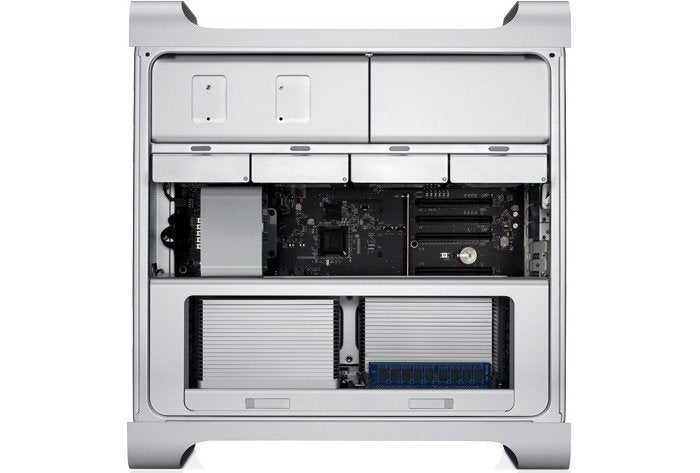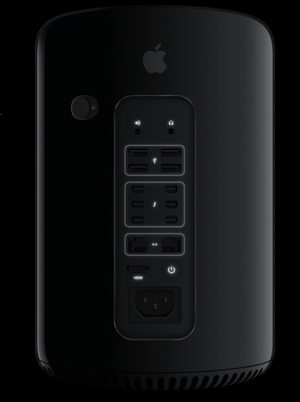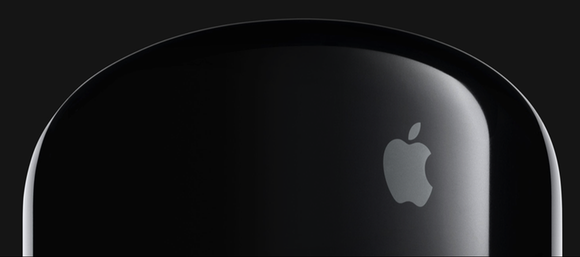When I first gazed upon the radically redesigned, supercharged Mac Pro at Apple’s WWDC last June, my reaction was immediate: “This is my next computer.” The promise of lightning-fast speed combined with the allure of its futuristic cylindrical design seemed irresistible.
As it turns out, resistance was all too possible. With additional information now available, I’m certain that I won’t be purchasing a Mac Pro next month or at any other time in the foreseeable future. Further, I’m confident that many—possibly most—owners of earlier Mac Pros will reach a similar conclusion.
Out with the old?
On the floor beneath my desk sits the behemoth that is a 2009 Mac Pro. Combined with a 24-inch Cinema Display, that system cost around £2500 when I bought. While the Mac Pro could never be accused of being a bargain, the Pro’s superior specs and greater internal expandability were sufficient to make it worth the extra bucks for many users like me.
My Pro has performed exceedingly well over the years, but the setup is showing signs of age. It’s also not well equipped for the future: The machine has no Thunderbolt ports, no USB 3 ports, no 802.11ac Wi-Fi. Its fans, although not noisy, are far from silent, and the machine generates a lot of heat. And it’s no longer the fastest kid on the block—not by a long shot.
That’s why I initially added a new Mac Pro to my wish list. If Apple had not announced this Pro machine, I would have put an iMac on the list instead. The iMac’s specs have improved dramatically over the past few years. Indeed, many of my “power user” colleagues who formerly owned Mac Pros have already opted for an iMac. Some of them have found that even a MacBook Pro is sufficient for their needs.
Still, the new Mac Pro remains a seductive, if not essential, alternative. So what if it delivers more raw power than I need? Why not get one anyway? When I took a closer look, I discovered why not.
Internal expandability? Fahgettaboudit
One major attraction of a Mac Pro, compared to all other Macs, has been its internal expandability. No more. The new Mac Pro offers no internal hard drive or optical drive expansion bays—indeed, no hard drives or optical drives at all. The only internal storage is PCIe-based flash storage. Also absent are any PCI (or other) expansion slots. From what I’ve read, you can’t even swap out the video card. At least RAM remains user upgradable. It also appears that you’ll be able to upgrade the flash storage, though to perform that task you’ll have to use cards custom-designed for compatibility with the Mac Pro.
To those who question the wisdom of this shift, Apple offers a one-word answer: Thunderbolt. What used to be handled internally will now be handled via external Thunderbolt (and perhaps USB) peripherals. I know that Thunderbolt is fast, but I still doubt that the target audience for this machine will welcome the shift. For both aesthetic and practical reasons, keeping major peripherals internal is preferable. I certainly put this design change in the minus column.
Cost? Into the stratosphere
For me, however, what finally killed any inclination I had to buy a Mac Pro was the cost. I’m not saying that Apple is overcharging for what the Mac Pro delivers—the cylinder carries some serious power. And I was prepared to pay a premium price to get it. It’s just that the actual premium turned out to far exceed anything I had anticipated.
The cheapest (if that word can be applied at all in this context) Mac Pro is the $2999 quad-core configuration. This model would have to suffice, as upgrading to six or more cores would be prohibitively expensive for me, and unlikely to provide any noticeable boost to the software I use.
Regardless, the real shocker is that this Pro comes with only 256GB of storage. Even if you pony up the extra £700 for a six-core model, you get the same measly 256GB. This seems far too stingy for a high-end “pro” machine. In contrast, a new iMac with the hybrid Fusion Drive ships with at least 1TB of storage. I expected at least as much from the Mac Pro. Even my 2009 Mac Pro came with more storage out-of-the-box.
The only Apple-supplied way to get a 1TB Mac Pro is by upgrading the flash storage. Apple has not yet posted what such an upgrade will cost, but on the current iMac, upgrading from 256GB to 1TB of flash storage adds £500 to the price; I expect the price jump to be about the same for a Mac Pro. That’s expensive any way you slice it. In a few years, as the cost of flash storage (hopefully) falls and Apple increases the minimum amount included with a Mac Pro, I’m sure the company’s decision to go flash-only will look prescient. For now, though, it makes for a very costly upgrade that many users may see as essential.
True, you could use an external drive to expand storage. But, as I indicated already, I much prefer to have the entire contents of my startup drive inside the Mac, rather than depending on a Thunderbolt peripheral for this task.
The new Mac Pro’s base configuration comes with only 12GB of RAM, too. Given that more RAM almost always translates into improved overall speed, I’d likely bump that to at least 16GB, and more likely to 32GB. Again, the higher numbers seem more in keeping with the overall power of the machine.
Next, to maintain parity with the specs of my old Mac Pro, I’d have to add external optical drives and perhaps additional external hard drives. Finally, I’d have to include an Apple Thunderbolt Display. (I’m not even dreaming about a possible 4K display here.)
Using iMac-based estimates when necessary, I calculated that the final cost of my “minimal” Mac Pro setup would land well north of £3000, not including sales tax. That’s much more than I paid for my old Mac Pro setup, and it’s way beyond what I would be willing to pay for a machine that isn’t essential for the work I do. Consider this: For about the same price, I could buy two 27-inch iMacs, each with 1TB Fusion drives, plus two iPads. And if you decide to go beyond a minimal Mac Pro setup, the cost soars even higher.
In with the new?
Over the past few years, as the existing Mac Pro has languished, speculation grew that Apple was preparing to abandon the high-end professional market altogether. The good news is that such speculation was wrong.
The new Mac Pro is almost here, and Apple clearly wants to make a statement with it. With a trailer showing in movie theaters this past summer and large posters recently mailed to selected journalists, a big publicity push has been underway.
This doesn’t mean that Apple expects the machine to have mass appeal. Rather, the company wants to showcase its completely redesigned high-performance machine—one that may set a standard for years to come and that should add polish to Apple’s public image. Think of it as the computer equivalent of the concept cars that automakers show off—except that it’s a computer you can actually buy.
Despite its high cost and limited expandability, I expect the new Mac Pro to appeal to a small but profitable professional market—just as automobiles that run upward of £100,000 do.
Because of its lower cost, the departing Mac Pro attracted a broader range of users, many of whom were not graphic artists, video producers, or other professionals. If you were a prosumer who wanted the most powerful and expandable Mac you could get, you went with the Mac Pro. But the new Mac Pro is a different animal. For those of us who have treated the Mac Pro as an affordable luxury, akin to today’s MacBook Pro, the new Mac Pro will likely seem impractical and extravagant, almost to the point of being frivolous.
Apple seems to be okay with this result. Since mobile devices now make up the largest segment of its revenue by far, Apple need not be concerned that its Mac Pro market might significantly shrink; the company may even welcome this. The new Mac Pro is a machine whose design shows no evidence of having been constrained by concerns over who could afford it. If this means that the Mac Pro’s escalating costs put the machine out of reach of many potential buyers, well, the iMac and MacBook Pro are always there to fill the void.







